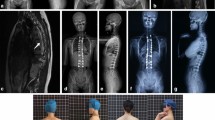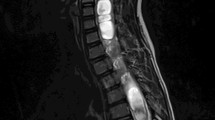Abstract
Purpose
To evaluate the effectiveness of brace treatment in patients with Chiari malformation type 1 (CM-1) or syringomyelia associated scoliosis without neurosurgical intervention.
Methods
This was a retrospective case–control study. 34 CM-1 or syringomyelia (CMS) patients who received brace treatment without neurosurgical intervention were recruited. Another 68 matched patients with idiopathic scoliosis who received bracing served as the control group. The matching criteria included gender, age (± 1 years), Risser sign (± 1 grade), initial curve magnitude (± 5°), curve patterns and follow-up time (± 6 months). Patients who encountered curve progression and scoliosis surgery were compared between different groups.
Results
Until the last visit, 16 (47%) patients in CMS group and 18 (26%) patients in IS group occurred curve progression; 9 (26%) patients and 15 (22%) patients underwent scoliosis surgery, respectively. Compared to idiopathic scoliosis, patients with CMS-associated scoliosis had a significantly higher rate of curve progression (P = 0.038). However, no significant difference was observed between two groups regarding to the rate of surgery (P = 0.867). Patients with combined CM-1 and syringomyelia had a higher rate of surgery than patients with isolated CM-1 or syringomyelia (P = 0.049). The double major curve pattern was identified as the risk factor for curve progression.
Conclusion
Brace treatment is effective for CMS-associated scoliosis without neurosurgical intervention. Compared to idiopathic scoliosis, brace can provide similar prevention for scoliosis surgery in CMS patients, but slight or moderate curve progression may occur. Specifically, patients with combined CM-1 and syringomyelia should be followed closely with a higher expectation of curve progression.



Similar content being viewed by others
References
Weinstein S, Dolan L, Wright J, Dobbs M (2013) Effects of bracing in adolescents with idiopathic scoliosis. N Engl J Med 369(16):1512–1521. https://doi.org/10.1056/NEJMoa1307337
Sponseller P, Bhimani M, Solacoff D, Dormans J (2000) Results of brace treatment of scoliosis in Marfan syndrome. Spine 25(18):2350–2354
Wang Y, Feng Z, Wu Z, Qiu Y, Zhu Z, Xu L (2019) Brace treatment can serve as a time-buying tactic for patients with congenital scoliosis. J Orthop Surg Res 14(1):194. https://doi.org/10.1186/s13018-019-1244-4
Eule J, Erickson M, O’Brien M, Handler M (2002) Chiari I malformation associated with syringomyelia and scoliosis: a twenty-year review of surgical and nonsurgical treatment in a pediatric population. Spine. https://doi.org/10.1097/00007632-200207010-00015
Ravindra V, Onwuzulike K, Heller R, Quigley R, Smith J, Dailey A, Brockmeyer D (2018) Chiari-related scoliosis: a single-center experience with long-term radiographic follow-up and relationship to deformity correction. J Neurosurg Pediatr 21(2):185–189. https://doi.org/10.3171/2017.8.Peds17318
Strahle J, Muraszko K, Kapurch J, Bapuraj J, Garton H, Maher C (2011) Chiari malformation Type I and syrinx in children undergoing magnetic resonance imaging. J Neurosurg Pediatr 8(2):205–213. https://doi.org/10.3171/2011.5.Peds1121
Strahle J, Smith B, Martinez M, Bapuraj J, Muraszko K, Garton H, Maher C (2015) The association between Chiari malformation Type I, spinal syrinx, and scoliosis. J Neurosurg Pediatr 15(6):607–611. https://doi.org/10.3171/2014.11.Peds14135
Tubbs R, Beckman J, Naftel R, Chern J, Wellons J, Rozzelle C, Blount J, Oakes W (2011) Institutional experience with 500 cases of surgically treated pediatric Chiari malformation Type I. J Neurosurg Pediatr 7(3):248–256. https://doi.org/10.3171/2010.12.Peds10379
Tubbs R, McGirt M, Oakes W (2003) Surgical experience in 130 pediatric patients with Chiari I malformations. J Neurosurg 99(2):291–296. https://doi.org/10.3171/jns.2003.99.2.0291
Batzdorf U, Khoo L, McArthur D (2007) Observations on spine deformity and syringomyelia. Neurosurgery. https://doi.org/10.1227/01.Neu.0000279971.87437.1f
Zhu Z, Sha S, Chu W, Yan H, Xie D, Liu Z, Sun X, Zhu W, Cheng J, Qiu Y (2016) Comparison of the scoliosis curve patterns and MRI syrinx cord characteristics of idiopathic syringomyelia versus Chiari I malformation. Eur Spine J 25(2):517–525. https://doi.org/10.1007/s00586-015-4108-6
Sha S, Zhu Z, Sun X, Zheng X, Liu Z, Wu T, Yan H, Qiu Y (2013) Effectiveness of brace treatment of Chiari malformation-associated scoliosis after posterior fossa decompression: a comparison with idiopathic scoliosis. Spine 38(5):E299–E305
Sha S, Zhu Z, Lam T, Sun X, Qian B, Jiang J, Cheng J, Qiu Y (2014) Brace treatment versus observation alone for scoliosis associated with Chiari I malformation following posterior fossa decompression: a cohort study of 54 patients. Eur Spine J 23(6):1224–1231. https://doi.org/10.1007/s00586-014-3265-3
Qiu Y, Sun X, Cheng JC, Zhu F, Li W, Zhu Z, Wang B, Yu Y (2008) Bone mineral accrual in osteopenic and non-osteopenic girls with idiopathic scoliosis during bracing treatment. Spine. https://doi.org/10.1097/BRS.0b013e31817b5b9e
Wiley J, Thomson J, Mitchell T, Smith B, Banta J (2000) Effectiveness of the boston brace in treatment of large curves in adolescent idiopathic scoliosis. Spine. https://doi.org/10.1097/00007632-200009150-00010
Katz D, Durrani A (2001) Factors that influence outcome in bracing large curves in patients with adolescent idiopathic scoliosis. Spine 26(21):2354–2361
Aboulezz A, Sartor K, Geyer C, Gado M (1985) Position of cerebellar tonsils in the normal population and in patients with Chiari malformation: a quantitative approach with MR imaging. J Comput Assist Tomogr 9(6):1033–1036. https://doi.org/10.1097/00004728-198511000-00005
Haroun R, Guarnieri M, Meadow J, Kraut M, Carson B (2000) Current opinions for the treatment of syringomyelia and chiari malformations: survey of the Pediatric Section of the American Association of Neurological Surgeons. Pediatr Neurosurg 33(6):311–317. https://doi.org/10.1159/000055977
Singhal A, Cheong A, Steinbok P (2018) International survey on the management of Chiari 1 malformation and syringomyelia: evolving worldwide opinions. Childs Nerv Syst 34(6):1177–1182. https://doi.org/10.1007/s00381-018-3741-x
Pomeraniec I, Ksendzovsky A, Awad A, Fezeu F, Jane J (2016) Natural and surgical history of Chiari malformation Type I in the pediatric population. J Neurosurg Pediatr 17(3):343–352. https://doi.org/10.3171/2015.7.Peds1594
Whitson W, Lane J, Bauer D, Durham S (2015) A prospective natural history study of nonoperatively managed Chiari I malformation: does follow-up MRI surveillance alter surgical decision making? J Neurosurg Pediatr 16(2):159–166. https://doi.org/10.3171/2014.12.Peds14301
Nishizawa S, Yokoyama T, Yokota N, Tokuyama T, Ohta S (2001) Incidentally identified syringomyelia associated with Chiari I malformations: is early interventional surgery necessary? Neurosurgery. https://doi.org/10.1097/00006123-200109000-00018
Akhtar O, Rowe D (2008) Syringomyelia-associated scoliosis with and without the Chiari I malformation. J Am Acad Orthop Surg 16(7):407–417. https://doi.org/10.5435/00124635-200807000-00006
Charry O, Koop S, Winter R, Lonstein J, Denis F, Bailey W (1994) Syringomyelia and scoliosis: a review of twenty-five pediatric patients. J Pediatr Orthop 14(3):309–317. https://doi.org/10.1097/01241398-199405000-00007
Tokunaga M, Minami S, Isobe K, Moriya H, Kitahara H, Nakata Y (2001) Natural history of scoliosis in children with syringomyelia. J Bone Joint Surg Br 83(3):371–376. https://doi.org/10.1302/0301-620x.83b3.11021
Godzik J, Holekamp T, Limbrick D, Lenke L, Park T, Ray W, Bridwell K, Kelly M (2015) Risks and outcomes of spinal deformity surgery in Chiari malformation, Type 1, with syringomyelia versus adolescent idiopathic scoliosis. Spine J 15(9):2002–2008. https://doi.org/10.1016/j.spinee.2015.04.048
Godzik J, Dardas A, Kelly M, Holekamp T, Lenke L, Smyth M, Park T, Leonard J, Limbrick D (2016) Comparison of spinal deformity in children with Chiari I malformation with and without syringomyelia: matched cohort study. Eur Spine J 25(2):619–626. https://doi.org/10.1007/s00586-015-4011-1
Yan H, Han X, Jin M, Liu Z, Xie D, Sha S, Qiu Y, Zhu Z (2016) Morphometric features of posterior cranial fossa are different between Chiari I malformation with and without syringomyelia. Eur Spine J 25(7):2202–2209. https://doi.org/10.1007/s00586-016-4410-y
Funding
This work was supported by the Jiangsu Provincial Key Medical Center (Grant No. YXZXA2016009) and the National Natural Science Foundation of China (Grant No. 81772304).
Author information
Authors and Affiliations
Corresponding author
Ethics declarations
Conflict of interest
The authors declare that they have no conflict of interest.
Informed Consent
The manuscript submitted does not contain information about medical device/drug(s).
Additional information
Publisher's Note
Springer Nature remains neutral with regard to jurisdictional claims in published maps and institutional affiliations.
Rights and permissions
About this article
Cite this article
Zhang, T., Bao, H., Zhang, X. et al. Brace treatment for scoliosis secondary to chiari malformation type 1 or syringomyelia without neurosurgical intervention: A matched comparison with idiopathic scoliosis. Eur Spine J 30, 3482–3489 (2021). https://doi.org/10.1007/s00586-021-06958-2
Received:
Revised:
Accepted:
Published:
Issue Date:
DOI: https://doi.org/10.1007/s00586-021-06958-2




